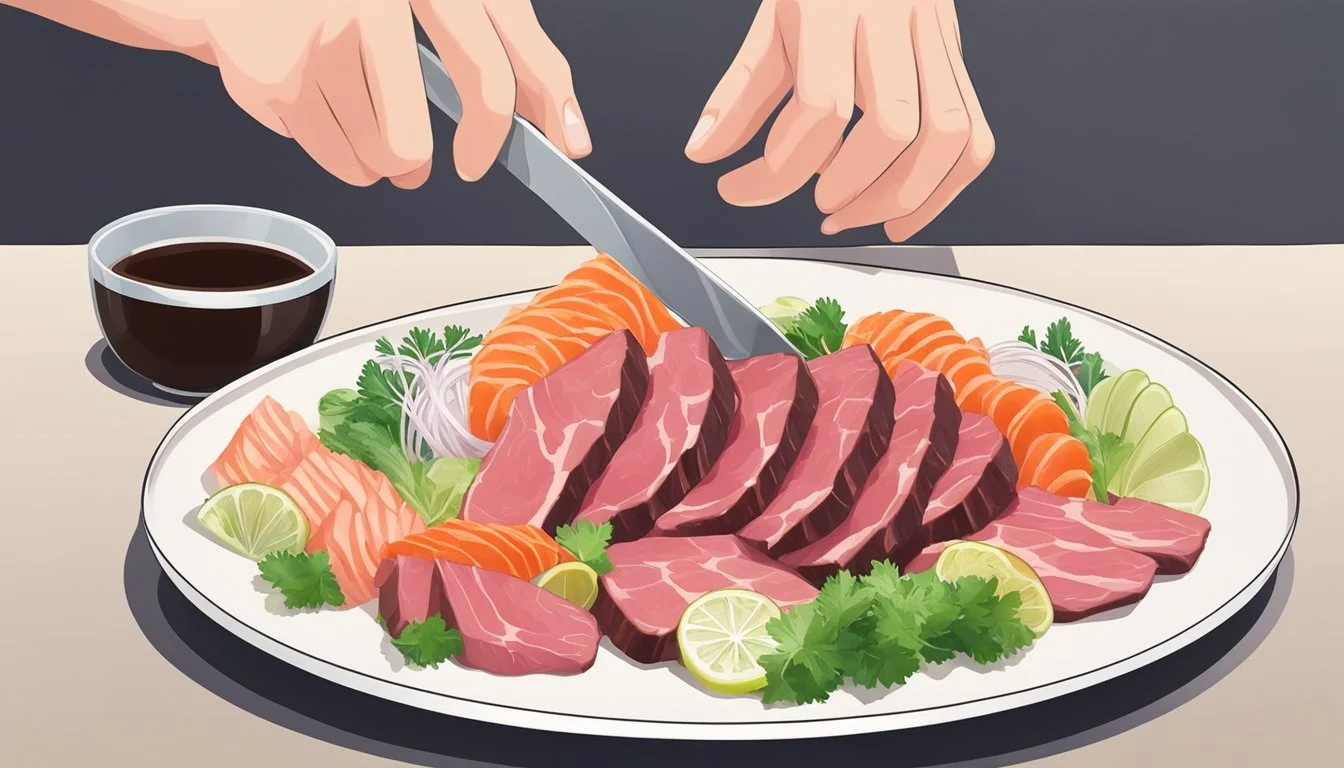Horse Sashimi Exploring the Unique Delicacy of Basashi in Japanese Cuisine
Horse sashimi, also known as basashi, is a gourmet dish emblematic of Japanese culinary tradition. Similar in preparation to fish-based sashimi, this delicacy consists of thin slices of raw horse meat and is highly regarded in regions like Kumamoto Prefecture. Basashi is celebrated for its unique taste and texture, often accompanied by traditional condiments like grated ginger, wasabi, and soy sauce.
The meat itself, referred to as 'sakura niku' or cherry blossom meat due to its pink hue, is appreciated for its tenderness and slightly sweet flavor. The dish offers a variety of textures depending on the cut, from the marbled 'toro', rich and fatty from the rib area, to the more textured 'futaego' from the neck, providing a more complex eating experience. Horse meat, generally leaner than beef, is also considered by some to be a healthier alternative rich in protein and low in fat.
While the consumption of horse meat may be a contentious subject in many cultures, in Japan, it is an accepted part of the culinary landscape. Basashi offers a distinct taste of Japan's regional cuisine, reflecting a long-standing history that intertwines local dietary preferences with cultural practices.
The Cultural Significance of Basashi
Basashi is deeply embedded in Japan's culinary history, shining as a unique facet of regional cuisine. This delicacy, enjoyed for its distinct taste and cultural value, holds a special place in Japanese cuisine.
Historical Roots
The inception of basashi can be traced back to the island of Kyushu, where it began as a traditional specialty of Kumamoto prefecture. Its preparation and consumption have historical ties to the samurai, who valued the dish for its nutritional properties. It was often served during wartime for its supposed energy-boosting abilities. Japan's reverence for the dish is such that it's also known as sakura niku (cherry blossom meat), linking it to the country's beloved cherry blossoms.
Regional Popularity
While basashi originated in Kumamoto, its popularity has spanned throughout Japan, with different regions offering their own variations. In Japan, basashi is more than just food; it's a symbol of regional pride and culinary craftsmanship. Each slice of this fine delicacy tells a story of cultural heritage, from the careful rearing of horses to the artful presentation of the meat. Basashi continues to be a sought-after dish in Japanese cuisine, valued for its lean texture, slightly sweet flavor, and the ritual accompanying its consumption.
Exploring the Delicacy of Basashi
Basashi is a culinary tradition steeped in the Japanese gastronomic culture, offering an experience that is both unique and distinctive among sashimi varieties.
Characteristics of Horse Sashimi
Basashi, known for its pure and slightly sweet flavor profile, is the culinary term for raw horse meat sashimi. Its visual appeal is prominent due to its intense red color, often compared to cherry blossoms, hence the nickname "sakura niku." Thickness of the slice and temperature are crucial; it is commonly served thinly sliced and chilled to enhance both its taste and texture.
Texture: Lean and tender
Flavor: Subtly sweet, less umami than other sashimi
Serving: Often garnished with grated ginger and accompanied by soy sauce
Comparison with Other Meats
Basashi stands out in the diverse world of meat due to its lower fat content and distinct taste when compared to more common meats like beef or seafood sashimi.
Basashi (Horse)
Fat: Lower
Flavor: Sweet Nuance
Color: Cherry Red
Beef Sashimi
Fat: Higher
Flavor: Rich
Color: Dark Red
Fish Sashimi
Fat: Variable
Flavor: Oceanic
Color: Translucent
Unlike beef, which has a richer flavor and often contains more marbling, basashi offers a leaner choice with unique sweetness. In contrast with fish sashimi, basashi does not carry the ocean's essence but rather stands on its own with a distinctly land-based savor.
Nutritional Profile of Horse Meat
Horse meat, often consumed in the form of sashimi known as Basashi in Japan, has a distinctive nutritional profile that contributes to its standing as a delicacy. It is a highly protein-rich food, which makes it an excellent source of this vital nutrient for muscle repair and maintenance.
Regarding calories, horse meat has a lower caloric count compared to some other meats, which can be beneficial for individuals monitoring their caloric intake. In terms of fat content, horse meat is relatively lean, offering a lower-fat alternative to those wishing to reduce their consumption of fatty meats.
Carbohydrates are typically absent from horse meat, as it is a pure source of protein and fat. This could make it a suitable option for those adhering to low-carbohydrate or ketogenic diets.
The health benefits of consuming horse meat include a rich source of iron and B vitamins, contributing to the overall nutritional value of the meat. As it is a low-fat source of protein, it may have a place in diets focused on heart health and weight management.
One should also be aware of the ethical considerations and the legal restrictions surrounding the consumption of horse meat in various cultures, which has limited its availability in some regions. However, in Japan, horse meat sashimi remains a noted aspect of the culinary tradition, appreciated for both its flavor and nutritional benefits.
Selecting and Preparing Basashi
When preparing Basashi, the selection of high-quality fresh horse meat is crucial. Chefs traditionally choose meat that is pink to dark red, signifying different maturity levels. The meat should exhibit freshness and a slight natural sweetness when tasted.
Selecting Basashi Cuts
Toro: Rib meat with marbled fatty streaks.
Lean: Lean meat from the horse, typically less marbled.
Futaego: From the neck, known for a firmer texture and higher fat content.
Preparation Steps
Storage: Store the meat at a constant, chilled temperature to maintain its freshness until slicing.
Slicing: Skilled chefs thinly slice the horse meat to enhance its delicate texture.
Presentation: The sliced meat is arranged artfully on a plate, sometimes over a bed of shredded daikon radish.
Seasoning
Garnishes: Accompany with grated ginger and finely sliced scallions.
Sauces: Soy sauce for dipping.
Handling Chefs must adhere to strict sanitary standards to prevent contamination, as Basashi is served raw.
It is imperative that a chef uses sharp knives to achieve the thinly sliced presentation that Basashi is known for. Each slice is a testament to the chef's precision and respect for the ingredients. Ingredients such as grated ginger and soy sauce not only complement the flavor of the dish but also add an extra layer of safety by providing antibacterial properties.
Serving and Enjoying Basashi
Basashi is a culinary tradition in Japan, where it's appreciated for its refined taste and texture. Thoroughly chilled to enhance its delicate flavors, it's often consumed as a delicacy. To fully appreciate basashi, one should pay attention to the nuances of its presentation and accompaniments.
Presentation: Basashi is typically presented in thin slices, displaying a deep, rich color. It is elegantly arranged on a platter, sometimes over a bed of shiso leaves, which add a touch of herby freshness.
Sauces and Condiments:
Soy Sauce: A staple for dipping, enhancing the meat's savory notes.
Grated Ginger: Often sprinkled on top for a zesty kick.
Other Condiments: Can include green onions or garlic, depending on regional variations and personal preference.
Eating Basashi:
Step 1: Select a slice and dip lightly into soy sauce.
Step 2: Add a small amount of grated ginger onto the meat.
Step 3: Consume in a single, respectful bite, savoring the combination of flavors.
The dish is best enjoyed with a clear palate to fully appreciate its natural, slightly sweet taste and tender texture. It's recommended to pair basashi with sake or a light beer to complement its flavors without overpowering them. When dining, diners should remain mindful of the cultural significance of basashi, appreciating the care and tradition that goes into its preparation.
The Best Places to Experience Basashi
To savor Basashi, a traditional Japanese delicacy of raw horse meat, food enthusiasts head to Kumamoto, the heartland of this unique cuisine. Kumamoto Prefecture is renowned for its high-quality Basashi, where it is not only a local food but also a reflection of the area's culinary heritage.
Aso, with its verdant landscapes, nurtures the perfect environment for breeding horses, making it an authentic spot for trying Basashi. Suganoya is a prominent restaurant in Kumamoto known for serving various cuts of horse sashimi, ensuring a genuine taste experience.
In Kyushu, the larger geographical region encompassing Kumamoto, visitors can indulge in this specialty where it's most traditional. Restaurants here serve Basashi with standard garnishes like grated ginger and soy sauce, which complement the meat's natural flavors.
Venturing northward to Nagano Prefecture offers another perspective on Basashi. While Nagano is not as universally recognized for horse meat as Kumamoto, it does provide its own regional take on the dish.
Kumamoto: Suganoya
Aso: Local Dining Spots
Kyushu: Various Traditional Eateries
Nagano: Selected Regional Spots
Visitors to these regions will find that Basashi is more than just a meal; it's a cultural journey through Japan's diverse and nuanced culinary landscape. For a comprehensive experience, it is suggested that one tries Basashi in a few different settings, each offering its own preparation style and ambiance.
Culinary Techniques and Variations
Basashi, or horse sashimi, is traditionally prepared with utmost care to maintain its delicate flavor and texture. Chefs typically slice the raw horse meat into thin pieces to enhance its tender feel. This technique is crucial as it influences both the taste and the dining experience. Grating ginger, soy sauce, and possibly green onions usually accompany the slices to complement the sashimi's natural sweetness.
The meat itself offers a range of textures and flavors depending on the cut. For instance, the 'Toro' cut, known for its rich, fatty quality, is highly sought after.
Basashi is not only consumed as sashimi but also appears in other dining formats:
Yakiniku: Horse meat is grilled tableside, providing a hands-on culinary experience.
Shabu-shabu: Thinly sliced meat is swished in a pot of boiling water or broth, cooking quickly and intended to be eaten immediately.
In some specialty establishments, like Tengoku Honten in Kumamoto Prefecture, diners may find basashi served in diverse styles, such as:
Sushi: Served atop a small ball of rice, akin to nigiri sushi (What wine goes well with sushi?).
Steak: Served lightly seared, preserving the raw, sashimi-like interior.
Lunch: Offered as part of a larger meal, often at midday.
Through these variations, the dish demonstrates versatility while still revered as a classic Japanese delicacy. Chefs across Japan honor the tradition of basashi, ingeniously incorporating the dish into modern dining experiences without compromising its esteemed origin.
Basashi in International Cuisine
Basashi—Japan's raw horse meat delicacy—while less known on the global culinary stage, has counterparts and influences beyond its origin. In Belgium, a European country renowned for its culinary diversity, horse meat is similarly enjoyed, although typically in smoked or cooked forms rather than raw.
The consumption of horse meat can be compared to the appreciation of other game meats such as venison (What wine goes well with venison?), which is widely adopted in various cuisines but differs in preparation. Venison is often incorporated into dishes where the meat's robust flavor is celebrated, much like the distinct, slightly sweet taste horse meat brings to basashi.
Sake—a Japanese rice wine—complements basashi, as its subtle flavors enhance the sashimi experience. International receptions of this combination may vary, but the pairing is reminiscent of regional preferences for pairing wines with specific cuts of raw or smoked meats (What wine goes well with smoked meats?).
Incorporating basashi into international cuisine requires thoughtful presentation and an understanding of local tastes. Educating diners about its cultural significance can enrich their experience. Here is a brief overview of how basashi might be positioned within international cuisine:
Belgium: Smoked and cooked horse meat, An exotic, raw variation
General Game: Venison, often cooked or smoked, Similar rarity, served raw
Complementary: Wine pairings with quality meats, Sake as an enhancing companion to basashi
Culinary enthusiasts seeking an exotic yet authentic experience may find basashi a fascinating exploration into the world of raw delicacies, significantly when served with sake, drawing parallels with international customs of pairing drinks with rare dishes.
Safety and Quality Controls
When consuming Basashi, safety and quality controls are paramount due to the potential presence of deadly bacteria such as E. coli and Salmonella. To mitigate these risks, producers must adhere to stringent regulations during the slaughtering and preparation processes.
Sarcocystis is another concern; it's a parasite that can be found in raw horse meat. Hence, ensuring meat quality involves testing and thorough inspection. Regular health checks of the horses are also integral to the farm-to-table pathway.
In Japan, specific guidelines ensure that the producers supply high quality meat:
Inspection: All horse meat intended for raw consumption undergoes a detailed inspection to detect parasites and bacterial contamination.
Temperature Control: The meat must be stored and transported at regulated temperatures to slow bacterial growth.
Certified Suppliers: Restaurants often source Basashi from certified suppliers known for high standards of animal husbandry and food safety.
Here's a quick overview of the controls in place:
Inspection of Meat: Detection of parasites and bacteria
Temperature Regulation: Meat is kept at specific temperatures
Supplier Certification: Restaurants must source from approved suppliers
Health Checks of Livestock: Regular monitoring for signs of disease
Such measures are critical to maintain the delicacy's integrity and to uphold public health standards. Consumers can enjoy Basashi knowing there are protocols to safeguard their dining experience.
Cultural Perspectives and Ethical Considerations
Basashi, or sakura niku as it's locally referred to, is deeply rooted in the food culture of Japan, specifically in Kumamoto Prefecture. In Kumamoto, residents view horse meat sashimi as both a tradition and a culinary identity. The term "sakura" denotes the pinkish hue of the meat, likened to the famous cherry blossoms or "sakura" for which Japan is renowned.
Cultural Acceptance:
In Japan, the consumption of horse meat is an established practice with historical significance. The dish itself garners respect and is a part of the gastronomic landscape. Diners often enjoy it with condiments like Japanese horseradish (wasabi) and soy sauce, appreciating the subtle flavors that are a point of pride for the region.
Despite its local acceptance, the practice does raise ethical questions internationally, where the treatment of horses and the consumption of their meat can be contentious. The perspective on eating horse meat varies greatly around the world, influenced by cultural norms, animal welfare concerns, and individual values.
Ethical Considerations:
Animal Rights: Ethical debates arise over the practice of consuming horse meat. Questions are often raised about the manner in which the horses are raised and slaughtered.
Cultural Relativism: What is considered ethical and acceptable in one culture can be viewed differently in another, highlighting the complexity of cross-cultural dietary norms.
In conclusion, basashi exemplifies how regional preferences and practices shape culinary traditions. However, ethical considerations related to animal rights vary significantly, differing by cultural context and personal beliefs.
The Economic Impact of Basashi Trade
Basashi has become more than just a culinary experience; it plays a significant role in the economic landscape of certain regions in Japan. In Kumamoto Prefecture, the birthplace of basashi, the trade contributes substantially to the local economy. Restaurants such as Suganoya and Tengoku cater to a niche market, serving high-grade horse sashimi to both local and international food enthusiasts.
Economic benefits are also seen in employment. Local businesses that specialize in basashi, like the renowned Suganoya Honten, support a chain of economic activities. They employ butchers, servers, and other staff, contributing to job creation in the region. Furthermore, the fame of basashi has transformed some establishments into tourist destinations, boosting the local tourism sector.
Kumamoto: Center of basashi trade, stimulates local economy
Restaurants: Demand for premium cuts increases revenue, supports employment
Historical figures like Kiyomasa Kato, a notable samurai, are often credited with the early development of horse meat consumption in Kumamoto. This heritage adds value and appeal, helping branded restaurants and basashi products to command higher prices, which in turn drives economic growth.
The trade has ripple effects across the region's economy, impacting farming, meat processing, hospitality, and gastronomy. These interconnected industries benefit from the sustained popularity of basashi, further cementing its status not just as a culinary tradition, but also as an economic asset.
Personal Experiences and Anecdotes
Travelers to Japan often recount their culinary adventures, sharing stories that showcase their encounters with local delicacies. Among these, basashi—horse sashimi—holds a fascinating place in their explorations. Diners describe the taste of basashi as clean and slightly sweet, with an unexpected tenderness.
One anecdote involves a first-time sampling of basashi at a traditional izakaya in Kumamoto. The individual recalls being served thin slices of the meat, beautifully arranged and garnished with grated ginger and soy sauce. They note the presence of various cuts, including the coveted toro, highly prized for its marbling.
Another experience highlights a visit to a specialty restaurant, where diners had the opportunity to try different parts of the horse, such as the heart and liver—both commended for their distinctive flavors and textures. These parts, often overlooked in Western cuisine, are considered delicacies in Japan.
Moreover, visitors mention accompaniments that enhance the basashi experience, like karashi renkon—lotus root filled with spicy mustard. It contrasts the meat's sweetness and adds a crunch that is both surprising and delightful.
Lastly, there are stories of discovering brisket cuts, which offer a different experience, with more chew and depth of flavor. People often express respect for the meticulous preparation and cultural significance that surrounds this dish, an appreciation that echoes through their narratives.








